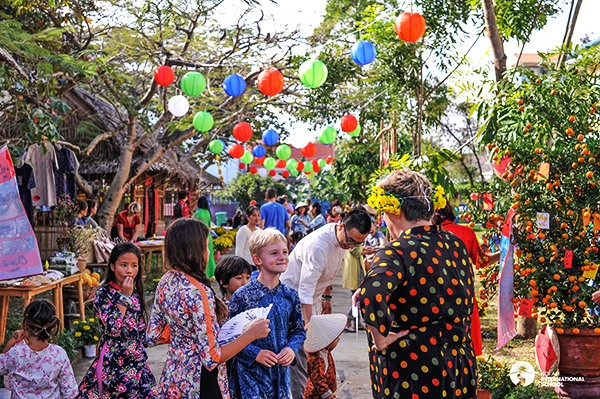It is obvious that Tet (Vietnamese Lunar New Year or Tet Nguyen Dan) is the national holiday of Vietnamese people and one of the most important Vietnamese festivals. Followings are some of Vietnamese New Year customs:

Admiring flowers
Tet atmosphere really starts on December. Those who planted peach blossom (Northern of Vietnam) and apricot blossom (Southern of Vietnam) know that in this day, people have to remove the leaves for the flower to bloom on the first day of the lunar new year.
Not everyone is doing this job because it is difficult to count the right day for changing factor such as weather, however, playing peach blossom, apricot blossom on Tet is a tradition, and making the flowers blooming on the first day of Tet only presents in Vietnam.
Time flies, the Tet holiday also has changed, but the traditional admiring flowers in Tet is still maintained until today with the more variety of flowers such as orchids, chrysanthemums, tulips ... planted from the country and imported from abroad.

Tien Ong Tao - Farewell ceremony to the Kitchen Gods
Legend has it that in every household since human has discovered the use of fire, Land Genie and Kitchen Gods has been there in the house to protect their people.
The Kitchen Gods are the gods of the kitchen who governs the cooking in each family, with the belief that "everything can be done after we eat". A kitchen has three Kitchen Gods.
Seven days (the 23rd night of the last lunar month) prior to Tet, each Vietnamese family offers a farewell ceremony for the Kitchen Gods and their means of transport - carps to go up to Heaven Palace.
His task is to make an annual report to the Jade Emperor of the family's affairs throughout the year. The farewell ceremony for the Kitchen Gods to heaven is a beautiful custom with spiritual meaning.

Banh Chung, Banh Day - Sticky rice cake
One of the most traditional special foods for New Years (Tet) of Vietnamese is Banh Chung or sticky rice cake. Banh Chung is made of sticky rice, pork meat and green bean, every ingredient is wrapper inside a special leaf which calls Dong.
Making the Banh Chung requires care and precision in every step while also requires skillful hands to make it a perfect square.
Every year during the New Year celebration, the Vietnamese people have to cook Banh Chung and Banh Day and use them as special offerings to their ancestors and enjoying it during the Tet celebrations.

Giao Thua - Lunar New Year Eve
In a literal translation, it means "Passage from the Old to the New Year" and in the Vietnamese belief, this is the time when heaven and earth meet.
Vietnamese people believe that there are 12 Sacred Animals from the Zodiac taking turn monitoring and controlling the affairs of the earth.
Thus, Giao Thua (New Year’s Eve)is the moment of seeing the old chief end his ruling term and pass his power to the new chief.
Giao Thua is also the time for Ong Tao (Kitchen God) to return to earth after making the report to the Jade Emperor. Every single family should offer an open-air ceremony to welcome him back to their kitchen with vegetarian food or normal food.
Along with that, there must always five type of fruits on the Vietnamese altar, including bananas (banana), grapefruit, mandarin, citrus in the south, and custard, coconut, papaya, mango and fig.
Li Xi - Lucky money

This is a cultural practice that has been maintained for generations, and has been an indispensable part in Vietnam’s customs of Tet Holiday , especially with children.
In the lunar new year, when meeting the adult, children will wish them for a happy new year and great health, showing respect and gratitude.
After that, it is the adults’ turn to give good advice and words of wisdom, encouraging the younger ones to keep up with the schoolwork, live harmoniously with others, and obey their parents and then giving them lucky money in a red envelope to welcome their new age.
Besides the money, the tiny red envelope also has its own meaning. It represents the secrecy and privacy to avoid comparison; as adults want the children regard the money as the gift of New Year, instead of being jealous of receiving less than other kids.
Moreover, the red color, the most popular color appearing in Vietnamese festivals, symbolizes luck and wealth according to Asian’s beliefs.
(Source: fancydistrict.com)